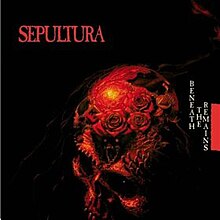Beneath the Remains
| Beneath the Remains | ||||
|---|---|---|---|---|
 |
||||
| Studio album by Sepultura | ||||
| Released | April 7, 1989 | |||
| Recorded | December 15–28, 1988 | |||
| Studio | Nas Nuvens Studio, Rio de Janeiro, Brazil | |||
| Genre | Thrash metal, death metal | |||
| Length | 41:48 | |||
| Label | Roadrunner | |||
| Producer | Scott Burns, Sepultura | |||
| Sepultura chronology | ||||
|
||||
| Professional ratings | |
|---|---|
| Review scores | |
| Source | Rating |
| AllMusic | |
| Q | |
Beneath the Remains is the third studio album and major label debut by Brazilian thrash metal band Sepultura, released on April 7, 1989. It was their first release by Roadrunner Records.
Beneath the Remains had improved production and songwriting compared to the band's previous albums. In time it would be acclaimed as a classic in the thrash metal genre. According to vocalist Max Cavalera, Sepultura had "really found [their] style" on that album.
This was their first album to feature a Michael Whelan cover art. There was a bit of controversy surrounding the cover art used for this album. Sepultura had initially planned on using another Michael Whelan cover art, Bloodcurdling Tales of Horror and the Macabre. Igor Cavalera had even gone so far as to get part of the painting tattooed on his arm. However, Roadrunner Records convinced Sepultura to use Nightmare in Red as they felt it was better suited for Beneath the Remains. Monte Conner of Roadrunner later sent the original artwork to Obituary, who used it on their album, Cause of Death, which was released a year after Beneath the Remains. For years after the incident, Igor Cavalera was upset with Monte Conner for giving away their album cover.
Max Cavalera travelled to New York in February 1988 and spent a whole week negotiating with the Roadrunner label. Although they offered a 7-record deal to Sepultura, the label was unsure of the band's sale potential. The album's budget was a small amount by the label's standards ($8,000), but in the end the cost was almost twice its original budget.
Scott Burns, who had previously engineered records by Florida death metal acts Obituary, Death and Morbid Angel, was the chosen producer. Burns agreed to work for a low fee ($2,000) because he was curious about Brazil. Sepultura spent the last half of December 1988 recording the album at Nas Nuvens Studio in Rio de Janeiro, from 8 pm to 5 am. Burns had brought some audio equipements and mesa boogie amps to brazil (A rare item for production standards at the time) which helped to improve the sound quality.
...
Wikipedia
